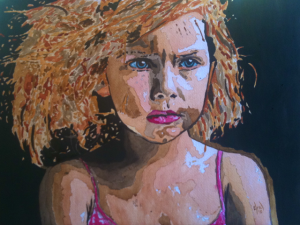 If you are an artist who also happens to be a Christian, expect to be judged and misunderstood.
If you are an artist who also happens to be a Christian, expect to be judged and misunderstood.
If you are a Christian and an artist, you live in the tension of creating art that is neatly wrapped up with a “happy ending,” art that is propaganda, and art that is shallow and without layers of meaning. In my experience, most of the Christian industry gatekeepers insist on one or all of these aspects of what I call “safe” art.
But there is a new generation of artists that happen to be Christians who refuse to bow to the almighty Christian dollar. They have decided to create “edgy” art not in order to be edgy but in the search for art that is true.
Why?
1.) Because they are not afraid of the darkness in themselves. Rembrandt painted his self-portrait 63 times not just as “a model for studies in expression” but as a “search for the spiritual through the channel of his innermost personality.” Rembrandt felt that he had to enter into his own self, into his dark cellars as well as into his light rooms, if he really wanted to penetrate the mystery of man’s interiority.
Rembrandt realized that what is most personal is most universal. While growing in age he was more and more able to touch the core of the human experience , in which individuals in their misery can recognize themselves and find “courage and new youth.”
We will never be able to create true art if we are not willing to paint and re-paint constantly our self-portrait, not as a morbid self-preoccupation, but as a service to those who are searching for some light in the midst of the darkness.
2.) Because they understand the healthy tension between art and propaganda. Author Philip Yancey, who also happens to be a Christian, writes, “Counterbalancing the literary tug away from propaganda, many evangelicals exert, an insidious tug away from art.
They would react to Tolstoy’s statement, ‘If someone were to tell me that it lay in my power to write a novel explaining every social question from a particular viewpoint that I believed to be the correct one, I still wouldn’t spend two hours on it. But if I were told that what I am writing will be read in twenty years time by the children of today, and that those children will laugh, weep, and learn to love life as they read, why then I would devote the whole of my life and energy to it,‘ with disbelief — to choose a novel that entertains and fosters a love for life over a treatise that solves every social (or, better, religious) question of humankind!
How can a person “waste” time with mere aesthetics — soothing music, pleasing art, entertaining literature — when injustice rules the nations and the decadent world marches ineluctably to destruction? Is this not fiddling while Rome burns? Currently, novels written by evangelicals tend toward the propagandistic (even to the extent of fictionalizing Bible stories and foretelling the Second Coming) and away from the artful.
Somewhere in this magnetic field between art and propaganda the Christian author (or painter or musician) works. One force tempts us to lower artistic standards and preach an unadorned message; another tempts us to submerge or even alter the message for the sake of artistic sensibilities.
Having lived in the midst of this tension for over a decade, I have come to recognize it as a healthy synthesizing tension that should be affirmed. Success often lies within the extremes: an author may succeed in the evangelical world by erring on the side of propaganda. But ever so slowly, the fissure between the Christian and secular worlds will yawn wider.
If we continue tilting toward propaganda, we will soon find ourselves writing and selling books to ourselves alone. On the other hand, the Christian author cannot simply absorb the literary standards of the larger world. Our ultimate goal cannot be a self-expression, but rather a God-expression.
3.) Because they know life has layers. Even Donkey in the movie Shrek knows this. Writer Madeline L’Engle states in an interview with Time magazine that one of the reasons she loves reading the Holy Bible is because it has layers—layers of meaning.
The artist writers of the Old Testament did not shy away from portraying the depths of depravity and heights of redemption. If the Old Testament were a movie today, it would be considered edgy at the very least. With scenes of incest, murder, lust, child sacrifice, magic and much more, the Bible does not shy away, as the typical Christian artist does, from vividly painting the layers of real life.
My thanks to Jeff Goins Christians Writing Edgy for the Wrong Reasons? for inspiration for this post.
What do you think?
Should Christians create “edgy” art?
Leave a Reply